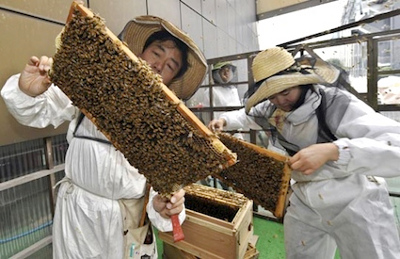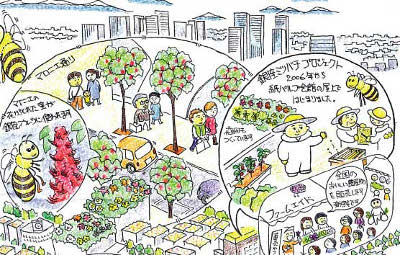
Colony collapse disorder is different in Japan
John
Little is a regular reader who lives in Japan and shared the following
fascinating data about differences between colony collapse disorder
there and in the U.S. I'll let him tell you the story in his own
words.
 On a different subject, bees
and CCD [colony
collapse disorder],
I recently came across some local (Japanese) information which seems,
on the face of it, to confirm the neonicotenoid connection. At an
apple growers meeting a couple of weeks back, one of the members
brought along a pre-release version of a documentary on DVD called "A
message from the bees".
On a different subject, bees
and CCD [colony
collapse disorder],
I recently came across some local (Japanese) information which seems,
on the face of it, to confirm the neonicotenoid connection. At an
apple growers meeting a couple of weeks back, one of the members
brought along a pre-release version of a documentary on DVD called "A
message from the bees".
Basically, there were
two critical points which differentiate the experience of
CCD here in Japan from
what is generally being seen in Europe and the U.S. The first is
that beekeepers here are
seeing different symptoms. Instead of empty hives, they're
finding piles of dead and incapacitated bees on the bottom boards and
in front of the hives. In the majority of cases, the deaths have
been correlated to local spraying of neonicotenoid-based insecticides
60 days before.
The second piece of
interesting information is that the spray dosage levels in Japan are
much, much higher than
in most of the rest of the world. For the common insecticides
used by fruit growers, the allowable levels (in ppm) are 20 to 300
(yes, three hundred!) times those mandated in Europe or the U.S.,
leading researchers here to the conclusion that they have identified a
"smoking gun".

As one old beekeeper
from the coast of Nagasaki-ken (in southern Japan) put it, "The centre
of Tokyo is now the safest place to raise bees. The air there is
cleaner than any part of the Japanese countryside".
Scary information
(especially for those of us who are involved in agriculture). And
the "message" from the bees? "You're not just killing us (bees),
you're killing
yourselves, too".
Want more in-depth information? Browse through our books.
Or explore more posts by date or by subject.
About us: Anna Hess and Mark Hamilton spent over a decade living self-sufficiently in the mountains of Virginia before moving north to start over from scratch in the foothills of Ohio. They've experimented with permaculture, no-till gardening, trailersteading, home-based microbusinesses and much more, writing about their adventures in both blogs and books.
Want to be notified when new comments are posted on this page? Click on the RSS button after you add a comment to subscribe to the comment feed, or simply check the box beside "email replies to me" while writing your comment.

You might want to inquire wether any of your neighbors has ever used any of these, especially imidacloprid (see the last link for trade names).
The more I read about this stuff, the less I like it. The link between imidacloprid and the death of bees seems strong as it is very toxic to them, and it is also highly toxic to aquatic invertebrates.
While imidacloprid seems to break down relatively fast (a couple of hours) when dissolved in water and subjected to sunlight, it can last for years when not subjected to sunlight.